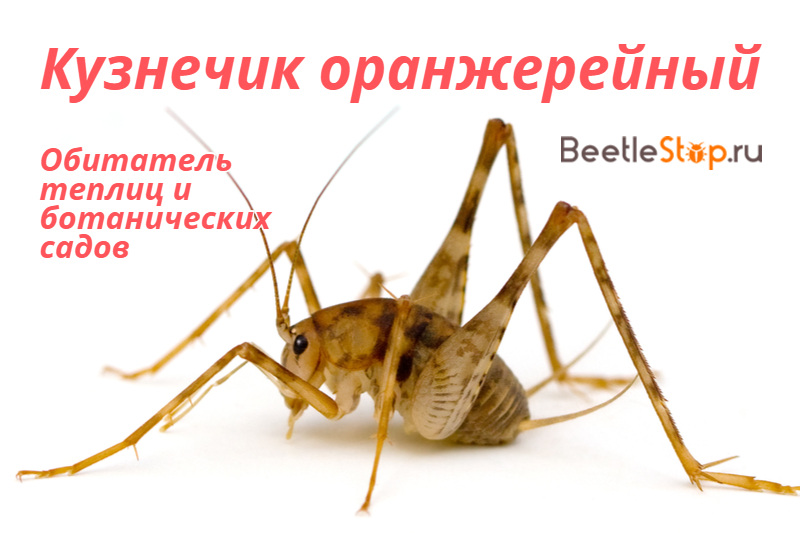Greenhouse Grasshopper - an alien from Central Asia
The greenhouse grasshopper belongs to the family of cave grasshoppers or rafidioforidov. (Rhaphidophoridae), which includes 550 species. These are long-winged orthoptera insects that have lost the ability to fly. Under natural conditions found in dark damp caves. Using a synanthropic connection with humans, insects settle in basements, sewers, ventilation shafts, where there is always high humidity and a stable warm temperature. There is enough organic matter, which is suitable food. A greenhouse grasshopper prefers to live in greenhouses, feed on plants.

View description
The greenhouse grasshopper (Tachycinesasynamorys) belongs to the family Orthoptera, the family Rhaphidophoridae. In appearance, the insect resembles a spider, it has a short, stocky, hunched body with a thick abdomen and long legs. The length of the female is 16-18 mm, the male is 13-15. An additional size for females is given by a long ovipositor, extending the abdomen by 10-11 mm. The main color is gray or brownish. The whole body is covered with a pattern of dark spots, stripes and bandages and short hairs that create a silky coating.
The wings and organs of hearing are completely absent. Without elytra, insects cannot chatter. The antennae are one of the most prominent parts of the body. The length of the organ is 2-4 times greater than the size of the body. The antennae perform several important functions, they are the organs of touch and help navigate in the dark.
Interesting fact. Hothouse grasshoppers have extremely developed hind limbs. They are able to jump to a height of 40 cm, and a length of up to 150 cm.
The order of Orthoptera is characterized by elongated hind limbs with developed hips. A Chinese grasshopper living in greenhouses has longer legs than other species. The size of the muscular thighs is equal to the size of the lower leg. The front and middle walking legs are also striking in size. The limbs are covered with bristles and spikes.
Spread
Most rafidioforides live in tropical latitudes. The homeland of the greenhouse grasshopper is Central China. The country's active trading activities contributed to the distribution of the species throughout Europe and North America. Together with vegetables, fruits and ornamental plants, orthopterans dispersed from local greenhouses. In the USA, insects appeared at the beginning of the 20th century, a little earlier in European cities. In some countries with a mild climate, they live in natural conditions. Seen in the Crimea.
Lifestyle
Inhabited exclusively in heated rooms, insects are active all year round. They are found in botanical gardens, greenhouses, greenhouses. They lead a nocturnal lifestyle, in the daytime they hide in crevices or plant debris. The timid ones, having heard an extraneous sound, make a jump to a considerable distance. Chinese greenhouse grasshoppers polyphages. They feed on parts of plants (leaves, young shoots) and small insects, larvae caught in greenhouses.
Information. Representatives of the species Tachycinesasynamorys can go without food for a long time, cannibalism is possible.
Propagation Features
In the process of mating, the male passes the spermatophore to the female, from which sperm enters the oviduct. Laying with the help of an ovipositor is placed in the ground.The female lays eggs in parts of 5-10 pieces, covering them with special secretions. Fertility of a female individual is 150-900 eggs of white color, oval in shape. Their length is 2 mm, width 1 mm. Larvae appear after 3-4 months. Outwardly, they are like adults. The development of young insects takes a long period - up to 7 months. During this time, a large number of links pass - 10 times.
Human Relationship
Cases of mass reproduction of insects in urban collectors are known. According to the sewage system, they moved to the apartments of the townspeople, causing a fright to the residents. In a hunched body with huge limbs, few recognized the grasshopper. Females scared people more than males. The cause was the saber-shaped ovipositor, taken as a poisonous sting. Despite the unusual appearance, the greenhouse grasshopper is absolutely safe for humans. If he settled in the house, then you can drive off an insect by lowering the level of humidity. It is enough to block his access to water, to eliminate all pipe leaks.
In greenhouses and greenhouses, Tachycinesasynamorys creates more problems than in a house. It feeds on plants, with mass reproduction it becomes a dangerous pest. Grasshoppers are gluttonous, imago and larvae eat flowers, vegetables and ornamental plants together. The insect is listed as pests of orchids, chrysanthemums, ferns growing in closed ground.


How lovely! I sat on my arm today, and not at all scary :)
I don’t know who had this insect on his arm, but it jumped on my bed in a hostel ... for people who are afraid of spiders (like me) this is a terrible sight, I have not experienced such horror for a long time?